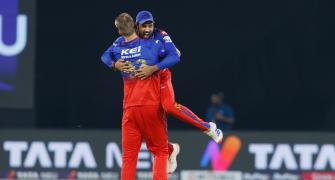In India, the sunglasses market is set to grow rapidly. Currently, estimated at Rs 300 crore (Rs 3 billion), it is expected to grow at 9 per cent per annum.
Sunglasses are seen so much as a fashion accessory today that people have almost forgotten that they can serve a real purpose: that of protecting the eyes from the sun's harmful rays.
Continued exposure to the sun's rays can significantly increase a person's risk of developing eye problems, such as cataracts.
In the short term, people who spend hours on the beach or in the sun without adequate eye protection can develop photokeratitis, reversible sunburn of the cornea, which can result in temporary loss of vision.
It is not just the sun's rays beating down on the earth. When sunlight reflects off of sand and water, it further increases exposure to harmful ultraviolet (UV) radiation.
It is a great myth that sunglasses are essential only in the summer. Everyone is at risk for eye damage from the sun year-round. It is worse when the sun is not really beating down for then people underestimate the situation and stay out longer resulting in greater exposure to harmful UV rays.
The Indian sunglasses market has been galvanized by the launch of Titan's Fastrack I-Gear, a new collection of sunglasses that starts at Rs 695 onwards.
It is the launch of the first indigenous sunglass brand in India and will be stocked in all Titan company outlets and major shopping malls.
So before you go out to pick a sunglass for yourself, here's everything you need to know about UV rays, frames, lenses and the brands available in the market.
UV Rays:
UV radiation in sunlight is invisible high-energy rays that lie just beyond the violet end of the visible light spectrum and are most dangerous to the eye. UV rays are divided into UVA, UVB and UVC.
UVA and UVB are the most dangerous and your sunglasses should block both forms. Don't assume that a more expensive or a darker sunglass offers you greater UV protection.
UV protection is offered by a coating on the lens of the glass.
When buying a sunglass look for a label that specifically states that the glasses offer 99 percent to 100 percent UV protection. Some like Titan write UV400 protection which means UV absorption up to 400 nanometers. This range includes the entire harmful UV spectrum.
Lenses:
First up are polarized lenses, which cut down on glare and reflection. Sand, water and snow are big-time sources of reflected sunlight.
Glare can also make you squint, which causes wrinkles slowly around your eyes. Polarized lenses restrict light to reduce the glare. A key thing to remember is that 'Polarized' and 'UV-blocking' are two independent features of a lens.
The second type of lens is photochromic lenses. They are the ones that get darker when you go outside and lighten when you go back inside. Their advantage is that you don't need both regular glasses and sunglasses.
The third is gradient lenses, which usually range from fairly dark at the top of the lens to a clear bottom.
Gradient lenses that are clear or light on the bottom make it easy to see the dashboard when you're driving, but are usually not effective enough if anything below your line of vision is reflecting light up back.
Lens quality is another important factor. You should see no distortion -- waviness or blurs -- either through the lenses, or reflected on the lenses. Also, make sure there
Tints:
UV protection is separate from the color of the lens, which is more a matter of what you like. From brown, grey, blue to orange and classic black, various tints are available in the market today.
A darker tint does not necessarily offer greater protection. Amber colored glasses are excellent at reducing the amount of blue light that reaches your eyes, but they can sometimes give a little trouble at traffic lights (for example, it can be difficult to see whether the green is lit).
If you have special needs . . .
If you wear regular glasses, get a separate pair of prescription sunglasses or photochromatic lenses.
If you wear contact lenses, definitely get a pair of sunglasses.
Even if your contacts block UV rays, you need to protect your whole eye, not just the part under the lens.
Quick tips for choosing sunglasses:
Check the label for UV protection:
UV or ultraviolet rays have three major bands: UV-A, UV-B and UV-C. Of these, UV-C does not matter; UV-A and UV-B are the ones to watch out for. Make sure the pair you buy offers protection against these.
Check for fit:
Fancy sunglasses that sit on the bridge of your nose lightly and look like they are barely in there might not be such a good idea. If you drive a two-wheeler or are out in the sun a lot, then it makes a lot more sense to buy a wrap around one that will cover your eyes well. A good pair should suit your face and serve a practical purpose too.
Check for the purpose you will be using it
If you are the kind who is out in the sun a lot then you need a pair that just offers a high degree of UV protection, so an ordinary glass will do. But if you use two-wheelers then you need a pair that will wrap around your eyes and protects it from flying dust particles when you drive. If you are in a place with a lot of glare, go for amber tinted glasses that will cut the glare and you can see through a greater distance.
Price ranges and brands available in the market today
-
The sub-600 rupees: These glasses are inexpensive and made locally. They come in the latest styles and are great for use and throw.
But they are optically unsafe. They provide no protection to your eye and in some cases might even hurt your eye because of the cheap quality of the lenses used.
These are commonly available in the roadside and selected shopping joints across various cities. Even big malls have many varieties in this price range and they form the bulk of the market. In the entire Shopper's Stop chain, sunglasses in this price range form the number one in the volume sold.
-
Between Rs 600 and Rs 1,500: Price-wise they provide the best deals, but there are not many options here. Titan has recently launched Fast Track sunglasses in this price range. However, that is available on in Bangalore for now.
The Fast Track brand of sunglasses promises 20 frames, 50 styles and a range of tints. The brand's sunglasses provide high quality UV protection and polarized lenses.
-
Over Rs 1,500: The high-end of the market it is dominated by imported brands. However, they offer only a limited choice in India. Designs are few and there is not update in the kind of styles made available.
Most popular brands in this range include Ray Ban, Killer Loop, Benetton and Police.







